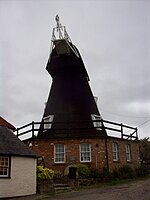The Kent Coalfield is a coalfield in the eastern part of the English county of Kent. The Coalfields Trust defines the Kent Coalfield as the wards of Barham Downs and Marshside in the Canterbury district, and the wards of Aylesham, Eastry, Eythorne & Shepherdswell, Middle Deal & Sholden, Mill Hill and North Deal in the Dover district.Coal was discovered in the area in 1890 while borings for an early Channel Tunnel project were taking place; the resultant Shakespeare colliery lasted until 1915.
In 1911, investigation into whether there was other workable coal was planned. Six 'bore holes' were put down in search of coal (at Rushbourne, Hoads Wood in Sturry, Herne Bay, Reculver, Chitty (which is near Chislet) and Chislet Park near the future site of Hersden). In the early years many collieries were sunk but were short-lived and the East Kent Light Railway was built to exploit the anticipated business.
Extensive plans had been drawn up by 1914 for major coal exploitation in east Kent, and the coalfield expanded rapidly in the late 1920s and early 1930s, with its maximum output reached in 1936. The outbreak of war and disappointing test results resulted in four collieries surviving: Betteshanger, Chislet, Snowdown and Tilmanstone. Had coal been more easily accessible, the open, rural landscape of east Kent could have changed beyond recognition.







